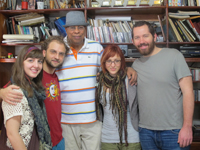Interarts Ensemble in Havana
 |
|
| From the left: Julia Easterlin, Enrico de Trizio, Chucho Valdés, Katie Bilinski, and John Hull. Cuban pianist Valdés met with the Berklee students at his home. | |
| Maria Magdalen Campos-Pons |
The rigor of Berklee can lead to a sort of tunnel vision for students focused completely on their own instrument or major. But in December, Berklee's Interarts Ensemble went to Cuba, and the group saw firsthand how different types of music and art can be strongly connected. The trip was shepherded by Electronic Production and Design Professor Neil Leonard.
"Cuban folkloric culture is by definition interdisciplinary art," says Leonard. "There's dance, recitation, music, food, clothing, and installation. The bembé [a Yoruban religious ceremony incorporating drumming, singing, and dancing] is interdisciplinary art in one of its really ancient forms."
The four members of the Interarts ensemble-students John Hull, Katie Bilinski, and Julia Easterlin, and alumnus Enrico de Trizio-make a far more modern form of interdisciplinary art, using laptops, iPads, looping pedals, and mixing boards for instruments.
For the first time, a group of Berklee students went to Cuba to collaborate with students at the Instituto Superior de Arte and the Laboratorio Nacional de Música Electroacústica. Ensemble members created and performed several pieces that drew on their surroundings.
As a result, their two shows incorporated diverse cultural influences and a variety of instruments. Videos portrayed visualization of the music, modern dancers interpreted compositions, Cuban poetry stitched together pieces by different composers, and laptops shared the stage with traditional batá drummers.
The Berklee ensemble experienced more Cuban music by observing a bembé in the Guanabacoa district of Havana. They also visited Grammy-winning pianist Chucho Valdés at his home. The students performed a composition for him, and he reciprocated by playing a song from his latest CD.
For Leonard, the trip was 25 years in the making. He first visited Cuba in 1986 and developed a relationship with electro-acoustic pioneer Juan Blanco. The experience not only enriched Leonard's music but also influenced his life. After returning to the United States, Leonard met Cuban visual artist María Magdalena Campos-Pons (then a student at Massachusetts College of Art and Design). The two later married.
Over the past few months, the Interarts Ensemble has created several hybrid works locally and internationally. The group created an audio-video performance with students at Boston's School of the Museum of Fine Arts that was broadcast live at the Videoformes Festival in France. Another piece used solar-wind data at the International Conference on Auditory Display in Washington, D.C., and the MusicAcoustic conference in Beijing. They also participated in a residency at the medieval Castello Malaspina in Italy and worked with artists from Folkwang Hochschule in Germany to create real-time computer animation.
"The Cuban concerts are another example of how far we can go in terms of interdisciplinary work," Leonard says. "All participants were deeply enthusiastic to see this cross-cultural dialogue actually bear fruit. It wasn't just a class; it was a real bridge."
